
When the re-capping service was initially established in the 1980s it was a relatively simple job, comprising a mere ten electrolytic and tantalum type capacitors (caps). The amplifiers that came in for service then were around five years old, so no other work appeared to be needed. These days, those same amplifiers can be up to thirty years older! Needless to say, they require extensive reconditioning throughout.
The current rebuild service involves up to eighty (80) key parts. The picture below shows a set of NAP 250 boards stripped of those parts (visible in the white container). The new parts, inclusive of a variety of capacitors, resistors, transistors, and diodes can be seen in the black tray, before being fitted to the rebuilt boards (as seen in the bottom picture).
Various other parts are replaced when rebuilding the chassis. For example sockets, cooling fan (for 135’s), and large reservoir capacitors in the power supply.
We essentially remanufacture the amplifier using specific techniques in a prescribed way. Then we test and re-align it to meet the original specification—at the very least—and often times significantly better. As each amplifier is put through its paces on the bench, we take as much time as necessary to examine the performance details across the full audio bandwidth, making repeated tuning adjustments to get the best results.
In order to achieve this advanced level of technical service, we have invested over $50,000 on test equipment, including the highly regarded Audio Precision ATS-1 analyzer. Uniquely, we also have Chris West on staff, whose extensive product experience working within Naim components is without parallel in the US. His expertise began at Naim’s UK facility, where for four years Chris managed production testing of every amp and power supply coming out of the workshop. If a unit didn’t pass, he ensured it received the additional attention needed to conform to spec. Most significantly, Chris benefitted a great deal from the training and ongoing advice of the man who designed the products, and who founded Naim Audio—the late Julian Vereker.
Beyond that, Chris has ten years of experience as the service manager for Naim in the US. Having tested and serviced literally thousands of amplifiers, Chris’ background and deep knowledge of Naim’s design philosophy and products puts him in a unique position to deliver the excellent standard of service that AVOptions offers to Naim Audio owners in the USA.
1) The heatsink module holding the amplifier power supply and fan control boards are extracted from the chassis.
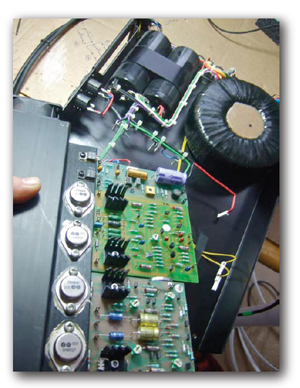
2) All assemblies are thoroughly cleaned using canned air and isopropyl alcohol. At this point, the thermally conductive paste that is used for the heat sinks in most Naim amplifiers and power supplies is removed. This provides the best starting point for the processes that follow.
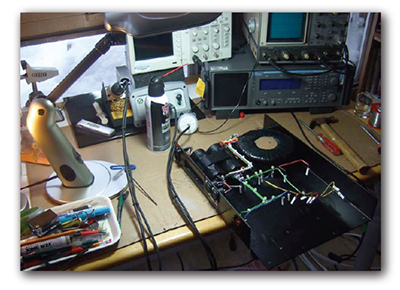
3) Spent main reservoir capacitors (used for smoothing the high currents from the power supply rectifiers) are unclamped. They may still be functional, but like changing an old sagging turntable belt, periodic replacement revives power supply performance.
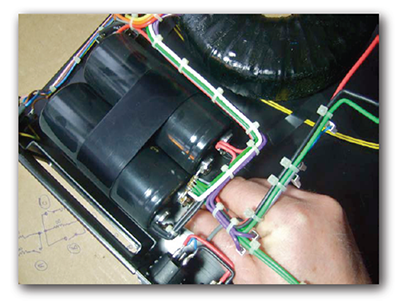
4) New reservoir capacitors are fitted, followed by firmly torquing down the terminals.
Notably, the brand (factory selected by system listening) can only be purchased in manufacturing level bulk quantities, and Naim exclusively source the needs of authorized service centers worldwide—including AVOptions.

5) Individual components are extracted from the Printed Circuit Boards using special de-soldering equipment. Temperature-controlled with a vacuum pump, it is used to quickly remove components without overheating delicate circuit traces or neighboring parts.

6) New parts kit prepared for the amplifier and power supply boards.

7) Modules from the pair of monoblock amps are ready for parts insertion. Each component needs to be properly and carefully inserted according to type. It is important to know the correct techniques for certain parts, which have been developed through years of refinements in Naim’s production process. Naim puts great emphasis on consistency in production, and this must be carried through to any servicing in order to maintain sonic performance.
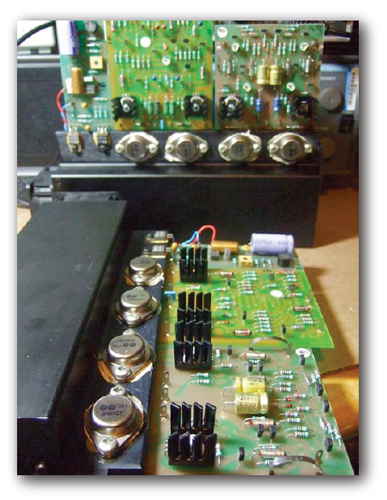
8) All new components are hand-soldered with the same type of lead/tin solder as originally used. The quality of the solder joints is crucial to reliability and performance.
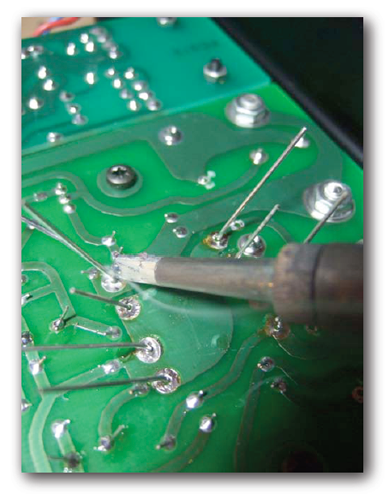
9) Just like factory Quality Assurance, a fully recapped module is inspected thoroughly. Every solder joint and component’s orientation in the circuitry is double checked before the module is fitted back in the chassis and reconnected.
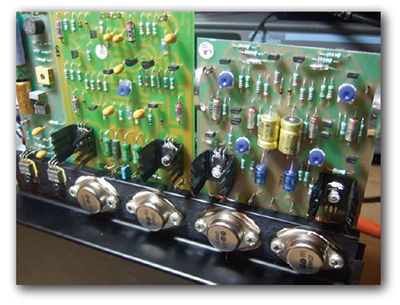
10) If new sockets are needed, minor mechanical alterations to the chassis are required before fitting. The amplifier can then be reassembled, ensuring that the wiring looms are properly arranged back to the original layout.
And this completes the rebuild process.
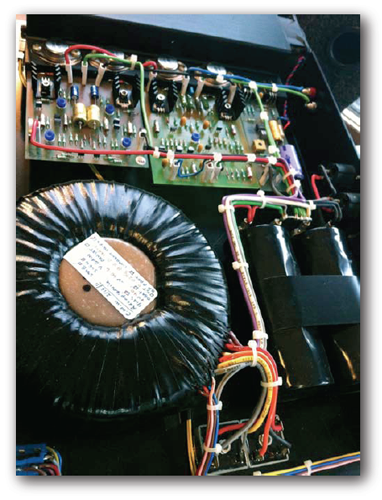
With the amp and power supply circuits restored, the amplifier is run through a batch of initial checks before it is re-aligned to factory specs. The regulated power supply voltage levels are set, the power amplifier output stage current bias is adjusted to an optimal value for minimum distortion, and the output is measured to make sure the direct drive circuitry has a very low DC offset voltage.
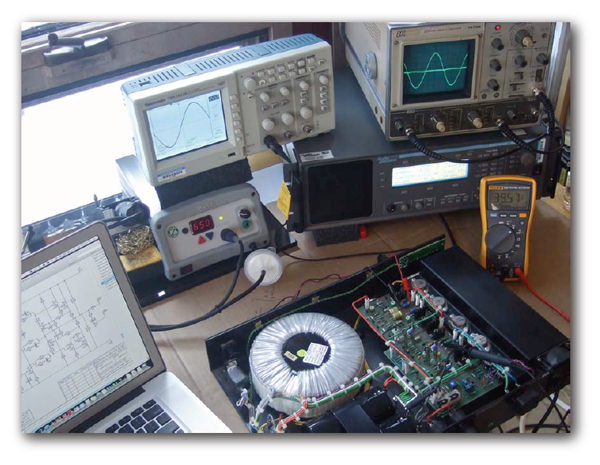
AVOptions Test Bench
The amplifier must then pass the same stringent tests under load that are applied at the factory. If not met, corrective steps are taken to result in a full pass. This begins by using the Audio Precision distortion analyzer to scrutinize circuit behavior to measure and observe how it performs across the full audio bandwidth, under a variety of loading conditions. At this point only experience can be used to interpret the test waveforms on display for any issues—and determine how to resolve them. At this stage operation of the output overload protection circuits is also verified. For amps with a cooling fan, the turn on temperature is set using an infrared thermometer to monitor heat-sync temperature.
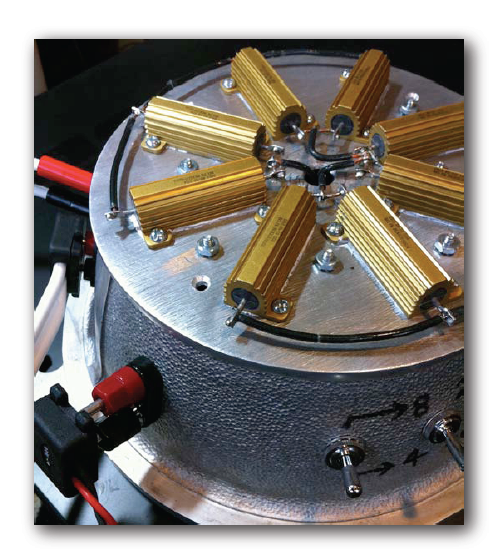
Custom Load Bay
This is an optimization process that is necessary for older Naim amps in particular, to achieve best performance under all circumstances. The amplifier is literally “tuned” to operate stably inside the full audio frequency range—down to the lowest expected and most difficult to drive loads. This is a very labor intensive and re-iterative task that the Audio Precision analyzer helps us accomplish. It reveals details of the amplifier’s behavior that are displayed by oscilloscopes in real–time. Experience in assessing the scope traces is crucial to getting an amplifier to “sing” by making informed adjustments to certain circuit component values. For equipment of Naim caliber, it can have a very significant impact on the final sound quality.

Sine wave instability detected and resolved
When the amplifier has satisfied all test conditions and passed stabilization, it is put into a full Naim system where final performance is assessed while playing music. Any discrepancies in sonic character and musicality will put it back on the bench for further examination and fine‐tuning.
The finishing step is a thoroughly detailed cleaning using the best materials for the job, with minor cosmetic blemishes attended to in the process. Careful packing ensures it will travel back safely and ready for its next duty cycle. New UK factory supplied packaging is also available. In addition to protecting your Naim component, proper factory packaging also adds significant value and desirability to your equipment in the Audiophile resale market. If you are missing the properly designed shipping cartons we cannot recommend this more strongly.